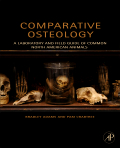Welcome
Welcome to the companion Web site for Adams, Crabtree: Comparative Osteology: A Laboratory and Field Guide of Common North American Animals. This site contains 171 selected images from the print volume with specific facets and points of interest labeled on the bones. Using the web tool 'Zoomify,' the reader can magnify and 'zoom into' unique facets on the bones, pan left, right, up or down, and if desired, magnify an image up to 40 times its original size. Descriptions of the labeled facets are included, as well as a complete description of each figure. We hope you find this tool helpful in your work - just click on 'Zoomify images' and get started!
In the forensic context it is quite common for nonhuman bones to be confused with human remains and end up in the medical examiner's or coroner's system. It is also quite common for skeletal remains (both human and nonhuman) to be discovered in archaeological contexts. While the difference between human and nonhuman bones is often very striking, it can also be quite subtle. Fragmentation only compounds the problem. The ability to differentiate between human and nonhuman bones is dependent on the training of the analyst and the available reference and/or comparative material.
Comparative Osteology is a photographic atlas of common North American animal bones designed for use as a laboratory and field guide by the forensic scientist or archaeologist. Adams and Crabtree present some of the most common species, which also have the highest likelihood of being confused with human remains.
This volume will benefit a large array of readers: forensic anthropologists, osteologists, medical examiners and coroners, forensic professionals in law enforcement and academia, archaeologists, and students in the biological, biophysical, biomedical, and paleontological sciences.

